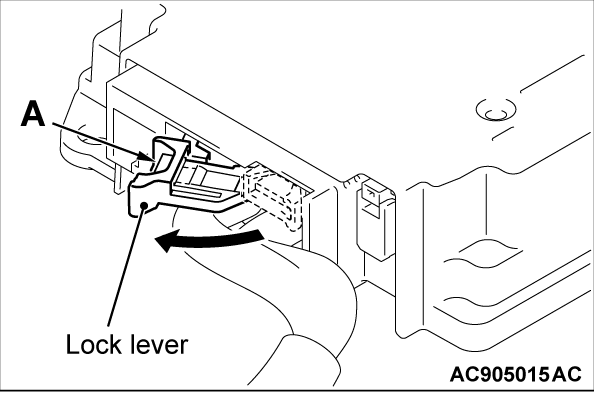DTC B1506: Seat Slide Sensor System Fault 1 (Open in the Seat Slide Sensor Circuit)
DTC B1507: Seat Slide Sensor System Fault Ground Circuit (Short-Circuited to Ground)
DTC B1508: Seat Slide Sensor System Fault Power Supply Circuit (Short-Circuited to Power Supply)
DTC B1507: Seat Slide Sensor System Fault Ground Circuit (Short-Circuited to Ground)
DTC B1508: Seat Slide Sensor System Fault Power Supply Circuit (Short-Circuited to Power Supply)
| caution | If DTC B1506, B1507 or B1508 are set in the SRS-ECU, always diagnose the CAN main bus lines. |
CIRCUIT OPERATION
- The seat slide sensor sets the current value Hi or Low determined by the seat position.
- The SRS-ECU determines the seat position according to the current value from the seat slide sensor.
DTC SET CONDITIONS
The DTC is set when the seat slide sensor output current is not within the specified range.
Cause of trouble for each DTC is as follows.
| DTC | SYMPTOM |
| B1506 | Open circuit in the seat slide sensor or harness |
| B1507 | Short to the ground in the seat slide sensor harness |
| B1508 | Short to the power supply in the seat slide sensor harness |
TROUBLESHOOTING HINTS
- Damaged wiring harnesses or connectors
- Short to ground in the seat slide sensor harness
- Malfunction of the SRS-ECU
- Malfunction of the seat slide sensor
DIAGNOSIS
STEP 1. Using scan tool (M.U.T.-IIISE), diagnose the CAN bus line.
(1)
| caution | To prevent damage to scan tool (M.U.T.-IIISE), always turn off the power supply mode of the electric motor switch before connecting or disconnecting scan tool (M.U.T.-IIISE). |
(2) Turn on the power supply mode of the electric motor switch.
(3) Diagnose the CAN bus line.
(4) Turn off the power supply mode of the electric motor switch.
Is the CAN bus line found to be normal?
STEP 2. Recheck for DTC.
Check again if the DTC is set.
(1) Erase the DTC.
(2) Turn on the power supply mode of the electric motor switch.
(3) Check if the DTC is set.
(4) Turn off the power supply mode of the electric motor switch.
Is the DTC set?
STEP 3. Resistance measurement at the SRS-ECU connector and the seat slide sensor connector (DTC B1506).
(1) Check that the negative battery terminal is disconnected. If the negative battery terminal is connected, disconnect it.
(2) While pushing the part "A" indicated in the figure of the harness side connector, turn the lock lever to the direction of the arrow to release the lock lever, and disconnect the SRS-ECU connector.
(3) Disconnect the seat slide sensor connector.
(4)
| caution | Do not insert a probe into the terminal from seat slide sensor connector harness side connector front side directly, as the connector contact pressure may be weakened. |
Check for continuity between the following terminals. It should be less than 2 ohms.
- Continuity DS1- line between SRS-ECU wiring harness side connector and the seat slide sensor connector
- Continuity DS1+ line between SRS-ECU wiring harness side connector and the seat slide sensor connector
Is the check result normal?
 Repair harness wires DS1-, DS1+ line between SRS-ECU connector and the seat slide sensor connector.
Repair harness wires DS1-, DS1+ line between SRS-ECU connector and the seat slide sensor connector.STEP 4. Check the harness short circuit between seat slide sensor connector and the SRS-ECU connector (DTC B1507).
(1) Disconnect the negative battery terminal.
(2) Disconnect the seat slide sensor connector.
(3) While pushing the part "A" indicated in the figure of the harness side connector, turn the lock lever to the direction of the arrow to release the lock lever, and disconnect the SRS-ECU connector.
(4) Measure the resistance between DS1-, DS1+ line and body ground (DTC B1507).
It should be open circuit.
Is the check result normal?
 Repair the harness wires DS1-, DS1+ line between SRS-ECU connector and the seat slide sensor connector.
Repair the harness wires DS1-, DS1+ line between SRS-ECU connector and the seat slide sensor connector. STEP 5. Check the harness short circuit between seat slide sensor connector and the SRS-ECU connector (DTC B1508).
(1) Disconnect the negative battery terminal.
(2) Disconnect the seat slide sensor connector.
(3) While pushing the part "A" indicated in the figure of the harness side connector, turn the lock lever to the direction of the arrow to release the lock lever, and disconnect the SRS-ECU connector.
(4) Connect the negative battery terminal.
(5) Electric motor switch: ON.
(6) Measure the voltage between DS1-, DS1+ line and body ground.
Voltage should measure 1 volt or less.
Is the check result normal?
 Repair the harness wires DS1-, DS1+ line between SRS-ECU connector and the seat slide sensor connector.
Repair the harness wires DS1-, DS1+ line between SRS-ECU connector and the seat slide sensor connector. STEP 6. Recheck for DTC.
Check again if the DTC is set. The procedure is complete.
The procedure is complete.
(1) Erase the DTC.
(2) Turn on the power supply mode of the electric motor switch.
(3) Check if the DTC is set.
(4) Turn off the power supply mode of the electric motor switch.
Is DTC B1506, B1507 or B1508 set?
 The procedure is complete.
The procedure is complete.![[Previous]](../../../buttons/fprev.png)
![[Next]](../../../buttons/fnext.png)


